In recent years, gardeners are increasingly using on their plots in different time years, on a par with , complex mineral fertilizers. They combine several types of nutrients.
Today it will not be possible to do without dressings in summer cottages. You can use ordinary manure as a fertilizer, but there will be no effect if the plants lack any specific element that is not in its composition. Complex mineral fertilizers are able to saturate plants in the garden (more details here) and in the garden with the trace elements they need. However, when applying these dressings, it must be borne in mind that for different cultures different feeds are suitable, and they are applied in different doses. Proper use of complex mineral fertilizers, combined with timely care, will lead to a good harvest.

Mineral supplements can be divided into 4 groups according to their composition.
1. Complex
They contain 2-3 chemical elements. Such dressings are highly concentrated and do not include ballast substances.
2. Mixed
Their basis is a combination of ready-made fertilizers and semi-finished products. Such feeding for plants are free-flowing, little caking.
3. Complexly mixed
The basis of such substances are chemical elements in combination with ready-made fertilizers and semi-finished products.
4. Combined
Such dressings include several types of nutrient salts. In the preparation, they are evenly spaced, so that the mixture is homogeneous.
At the same time, it is important that no matter how complex a substance is, the percentage of various useful elements in it is strictly maintained. In some situations, you can slightly change their ratio, for example, when a culture lacks a certain component. In this case, you can additionally make the necessary simple make-up containing the desired component.
Forms of application of mineral supplements
Mineral supplements can be added to different forms content.
Liquid
- Ammonia. They are a solution that is obtained by mixing nitrogen substances and ammonia water. The introduction of such recharge is carried out directly under the root of the plant,
- Ammonia water. It is the concentration (25%) of liquid ammonia diluted with water. If a liter bottle of liquid ammonia is diluted with 250 g of water, then ammonia water will be obtained.
In general, these substances can be bought, since fertilizers are commercially available ready for use. But you can cook them yourself, but the solution after manufacturing should be used immediately. Otherwise, all useful elements will evaporate, and only water will remain, in which there will be minerals, only in a very low concentration.
Solid
Complex minerals are sold in granules or powder. Solid form recharges are usually applied directly to the ground. Powder, as well as granules, are easily soluble in liquid, therefore, after their application, it is necessary to irrigate a little and loosen the soil.
Due to the fact that complex mineral supplements are presented in different forms, they become more versatile. After all, you can fertilize plants with their help, regardless of the growth period.
Types of complex and universal mineral fertilizers
To date, there are many different top dressings. Among the most popular are the following.
Ammophos
It is a nitrogen-phosphorus supplement. Ammophos does not contain chlorine, but nitrogen in the preparation contains 52%, and phosphorus - 11%. The fertilizer is universal, that is, it can be used on any land for fertilizing any crops. Its application rate per square is 20 gr.
diammofoska
It is a granular substance, which contains:
- Nitrogen - 10%,
- phosphorus - 26%,
- potassium - 26%.
And another option for the percentage of components:
- Nitrogen - 13%,
- phosphorus - 23%,
- potassium - 23%.
In addition to these elements, diammophos includes zinc, sulfur, iron and other useful elements. You can apply this mineral product under all plants on suburban area, observing the application rate (no more than 25 grams per square). Apply top dressing better in spring, during planting, as well as during their flowering.
Nitroammophoska
It is a complex fertilizer, which contains 16% potassium, nitrogen and phosphorus, as well as 2% sulfur. This is a universal feed, suitable not only for garden crops, but also for trees and other plantings in the garden and flower beds. Nitroammophoska can be applied on all kinds of soils, in proportion to one square - 50 gr. facilities.
Nitrophoska
Complex feed for all crops, containing 11% potassium and nitrogen, as well as 10% phosphorus. Nitrophoska is used as the main feeding of crops. You can use the drug on all lands, but on heavy lands it is recommended to apply before winter, and on light lands it is allowed in the spring.
station wagon
This is a complex granulated organomineral fertilizer that does not contain chlorine. The content of other components:
- Nitrogen - 7%,
- humic compounds - 3.2%,
- sulfur - 3.8%,
- potassium - 8%,
- phosphorus - 7%,
- iron - 0.1%.
In addition to them, the preparation contains useful trace elements, including manganese, boron, zinc. The "Universal" contains a large amount of humic substances and useful micro and macro elements. It can be used for any plants in the summer cottage, the drug does not acidify the ground. And most importantly, it is environmentally friendly. If the "Universal" is used periodically, then the humus content in the earth can be increased.
You can use this mineral supplement when plowing the garden, with this action, for cultivated areas, 100 grams of fertilizer per 1 square will be required, and for non-cultivated areas - 150 grams for a similar area. It should be added to the furrows or pits for planting, during the planting of seedlings, mixing 20 g of "Universal" with the soil. If recharge is required, then 30 g of the drug will be required per hundred square meters.
calcium nitrate
It is a special top dressing, and the basis of fertilizer are:
- Calcium - 19%,
- nitrogen - 15.5%.
Calcium nitrate is suitable for feeding all plants in the garden. Thanks to this tool, plants begin to grow intensively, the vegetative mass begins to form and develop better. Saltpeter is completely soluble in water.
Mortar
Complex, well soluble in water, mineral dressing containing the optimal ratio for all crops: potassium, phosphorus, nitrogen and magnesium and the necessary trace elements. You can use "Mortar" both for root dressings and for foliar dressings. All useful components available in the "Mortar" are quickly absorbed by cultures. The application rate is 16-24 grams per hundred square meters.
Magnesium sulfate
This complex tool contains components such as sulfur - 13% and magnesium - 16%. Basically, this fertilizer is used on acidic sandy and soddy-podzolic lands. Magnesium sulfate can be used alone or in combination with other mineral components, at a dosage of 11-14 grams per square.
Potassium monophosphate
This preparation contains potassium - 33%, as well as phosphorus - 50%. Feeding with potassium monophosphate leads to the normalization of the metabolic process. It is possible to feed the cultures both by the root method and by the non-root method, and it is desirable to carry out the latter in the morning or late in the evening.
Complex fertilizers: types and properties
Complex fertilizers include mineral fertilizers containing two or more nutrients. They are divided according to composition: double (nitrogen-phosphorus, NP; nitrogen-potassium, NK; phosphorus-potassium, PK) and triple (nitrogen-phosphorus-potassium, NPK).
Complex fertilizers
The range of complex fertilizers is mainly represented by the following forms: double nitrogen-phosphorus fertilizers - ammophos, nitroammophos and nitrophos and double phosphorus-potassium fertilizers - potassium phosphates, triple complex fertilizers - ammophoska, nitroammophoska and nitrophoska, magnesium-ammonium phosphate.
Rice. Types of complex fertilizers
According to the method of production, complex fertilizers are divided into complex, complex-mixed (combined) and mixed fertilizers. To complex fertilizers industrial production include fertilizers such as potassium nitrate, ammophos, diammophos. They are obtained by chemical interaction of the initial components. The composition of complex solid and liquid fertilizer in the process of their production, microelements, as well as herbicides and pesticides, can be introduced.
Compound or combined fertilizers include complex fertilizers obtained in a single technological process and containing two or three main plant nutrients in one granule, although in the form of different chemical compounds. They are produced by special both chemical and physical processing of primary raw materials or various one- and two-component fertilizers. These include: nitrophos and nitrophoska, nitroammophos and nitroammophoska, ammonium and potassium polyphosphates, carboammophos, phosphorus-potassium pressed fertilizers, liquid complex fertilizers. The ratio between the nutrients in these fertilizers is determined by the amount of raw materials when they are received.
Mixed fertilizers are mixtures of simple fertilizers obtained in the factory or at fertilizer mixing plants at the places of use of fertilizers by dry mixing.
Complex and complex-mixed fertilizers are characterized by a high concentration of nutrients, so the use of such fertilizers provides a significant reduction in the cost of the farm for their transportation, mixing, storage and application.
Among the disadvantages of complex fertilizers is that the proportions in the content of NPK in them vary within a narrow range. Therefore, when making, for example, the required amount of nitrogen, other nutrients are introduced less or more than required.
In a small amount, multifunctional fertilizers are also used, containing, in addition to the main nutrients, microelements and biostimulants that have a specific effect on the soil and plants.
In recent years, the production of fertilizer mixtures has begun to develop in Russia. Fertilizer mixtures are mechanically mixed, compatible types of fertilizers. Combining their composition, you can choose the best option for all cultures and regions. The use of fertilizer mixtures has long been common in countries with developed agriculture. In Russia, this process is just beginning.
Ammophos (monoammonium phosphate, MAP, NH4H2PO4) - is a highly concentrated granular nitrogen-phosphorus fertilizer, the nitrogen in which is represented by the ammonium form. The product is non-hygroscopic, non-dusty and non-caking. It has a uniform granulometric composition and is highly soluble in water. On the basis of ammophos, any brands of mixed fertilizers are prepared. Ammophos is a universal high-performance fertilizer used on all types of soil for the main and sowing application for all crops. It is applied in the conditions of the protected ground. It is advisable to use the product in arid areas, where nitrogen fertilizers are required much less than phosphate fertilizers.
Sulfoammophos ((NH4)2HPO4 + (NH4)2SO4) - is a universal water-soluble granular complex nitrogen-phosphorus fertilizer. The product is non-caking, non-hygroscopic, has an even granulometric composition, does not produce dust. It has a better solubility of phosphorus and a ratio of nitrogen and phosphorus compared to ammophos. Nitrogen in sulfoammophos is presented in the ammonium form, due to which it is weakly washed out of the soil and contributes to a more intensive absorption of phosphate ions by plant roots. The composition of this fertilizer includes sulfur, which contributes to an increase in the percentage of gluten in wheat, the oil content in sunflower, soybeans and rapeseed. The fertilizer also contains calcium and magnesium (0.5% each), which are important elements for plant life.
Sulfoammophos is applied on all types of soils and under all crops. This product It is used for the main, pre-sowing application, as well as for plant nutrition. Can be used in protected ground conditions together with nitrogen and potash fertilizers. Any mixed fertilizers are prepared on its basis. In Russia, the only producer of this fertilizer is EuroChem.
Diammonium phosphate (diammonium hydrogen phosphate) (NH4)2HPO4 is a concentrated, nitrate-free, water-soluble, granular nitrogen-phosphorus fertilizer. It is not hygroscopic, does not cake, has an even granulometric composition, does not produce dust.
Ammophoska NPK is a highly effective complex fertilizer containing three nutrients: nitrogen, phosphorus and potassium. This is a complex multicomponent system in which phosphorus and potassium are mainly represented by phosphates and potassium sulfate, nitrogen - by ammonium sulfate. The product is non-hygroscopic and does not cake. Nitrogen is present in the ammonium form, due to which it is weakly washed out of the soil and contributes to a more intensive absorption of phosphate ions by plant roots. The composition of this fertilizer includes sulfur, which contributes to an increase in the percentage of gluten in wheat, the oil content in sunflower, soybeans and rapeseed. In some cases, the fertilizer contains calcium and magnesium (0.5% each). Chlorine-free ammophoska is good fertilizer for saline soils. Ammofoska is applied as the main and sowing fertilizer on all types of soils for all agricultural crops (chlorine-free is especially preferable for chlorine-sensitive ones - fruit and berry crops, vegetables, potatoes, vineyards, tobacco, which improves product quality and increases its shelf life). It can be applied in the conditions of the protected ground.
Nitroammophos and nitroammophos are obtained by neutralizing mixtures of nitric and phosphoric acids with ammonia. Fertilizer obtained on the basis of monoammonium phosphate is called nitroammophos, with the introduction of potassium - nitroammophos. These complex fertilizers are distinguished by a higher content of nutrients than nitrophoska, and when they are obtained, there is ample opportunity to change the ratios between N, P and K in their composition. Nitroammophos can be produced with N content 30-10% and P2O5 27-14%. In nitroammophos, the total content of nutrients (N, P and K) is 51% (in grades<А>- 17-17-17 and<Б>- 13-19-19). Other brands are also produced. Nutrients, not only nitrogen and potassium, but also phosphorus, are contained in a water-soluble form and are readily available to plants. The effectiveness of nitroammophos is the same as a mixture of simple water-soluble fertilizers.
Liquid complex fertilizers (LCF) are obtained by neutralizing ortho- and polyphosphoric acids with ammonia with the addition of nitrogen-containing solutions (urea, ammonium nitrate) and potassium chloride or sulfate, and in some cases microelement salts. The total content of nutrients in liquid complex fertilizers based on orthophosphoric (extraction or thermal) acid is relatively low (24-30%), since salts crystallize and precipitate in more concentrated solutions at low temperatures. The ratio of nitrogen, phosphorus and potassium in the FCS can be different, the content of N-5 - 10%, P2O5-5-H and K2O - 6 - 10%. In our country, mainly fatty acids are produced with a nutrient ratio of 9:9:9, as well as with a different ratio (7:14:7; 6:18:6; 8:24:0, etc.).
On the basis of polyphosphoric acids, fatty acids with a higher total content of nutrients (more than 40%) are obtained, in particular, fertilizers with a composition of 10: 34: 0 and 11: 37: 0, which are obtained by saturating superphosphoric acid with ammonia. These basic fertilizers are used to obtain triple HCS of various compositions by adding urea or ammonium nitrate and potassium chloride to them.
When using liquid complex fertilizers, a set of special equipment is required for their transportation, storage and application. They can be used in the same ways as solid ones: by continuous distribution over the soil surface before plowing, cultivation and harrowing, during sowing, as well as in top dressing - during inter-row cultivation of tilled crops or superficially on continuous sowing crops.
Technical characteristics of ammophos according to GOST 18918-85
Name of indicator Norm according to GOST 18918 - 85 grade A
Top grade First grade
1 Mass fraction of total nitrogen (N), % 12 ± 1 12 ± 1
2 Mass fraction of digestible phosphates, % Mass fraction of total phosphates, % not less than 52- 50 ± 1 -
3 Mass fraction of water, %, not more than 1.0 1.0
4 Granulometric composition. Mass fraction of granules size:
Less than 1 mm, %, not more than 3.0 3.0
From 1 to 4 mm, % not less than 95 95
From 2 to 5 mm, %, not less - -
Less than 6 mm, % 100 100
Over 6 mm - -
5 Static strength of granules, MPa (kgf/cm2), not less than 3.0 (30) 3.0 (30)
6 Friability, %, not less than 100 100
Technical characteristics of sulfoammophos
Indicator Value for brand
14:34 20:20
Mass fraction of total nitrogen, % not less than 14 20
Mass fraction of total phosphates in terms of P2O5,% not less than 34 20
Mass fraction of sulfates in terms of sulfur, % not less than 8 8-13
Mass fraction of water, % no more than 1.0 1.5
Grading. Mass fraction of granules - less than 1 mm, % no more - from 2 to 5 mm, % not less - less than 6 mm, % 490100 390100
Static strength of granules, MPa, not less than 3.0 3.0
Friability, % 100 100
Specifications of diammonium phosphate
Name of indicator
Norm
Mass fraction of total phosphates (P205), %, not less than 46
Mass fraction of total nitrogen (N), %, not less than 18
Mass fraction of water, %, no more than 1.8
Granulometric composition, mass fraction of granules size:
up to 1 mm, %, no more than 3
2-5 mm, %, not less than 95
more than 6 mm, % 0
Static strength of granules, MPa, not less than 3
Appearance of the granule from white to black with different shades
Technical characteristics of NPK
As practice shows, in the battle for the harvest, not all means are equally good. If large agricultural enterprises use powerful "synthetic" fertilizers for vegetables, then many experienced gardeners use old-fashioned methods and also get good, and sometimes impressive, yields from year to year.
1 Fertilization - what do plants need?
In addition to timely watering, starting from the moment of sowing or planting seedlings, a necessary measure for the care of vegetable crops is the application of fertilizers that nourish the root system, stimulate the growth of tops and fruit ripening. The most convenient to use are complex fertilizers for vegetables, containing all the necessary elements. The balance of the formulations of dressings guarantees an excellent result.
You can determine the lack of certain trace elements by appearance tops. For example, if it has a pale green color, then it lacks nitrogen for full development., and vice versa, if the color of the tops is saturated dark green, this indicates its overabundance. To compensate for the lack of nitrogen in the soil, nitrogen supplements are used, with an excess.
Traditional supplements for vegetable crops used by gardeners:
- poultry droppings;
- cattle droppings.

To prepare a liquid top dressing based on them, the following proportions should be followed: 10–15 liters of litter (or 1–1.5 buckets) are added to a container of 40–50 liters. This is all mixed and infused for two to three days. The appearance of bubbles and a strong smell indicate the readiness of top dressing. Top dressing is done in the process of evening watering. Ready liquid top dressing is diluted with water in a ratio of 1 to 4 or 5.
In order for the top dressing to hit the target exactly, it is advisable to make grooves between the rows and lower the spout of the watering can closer to the ground.
These for vegetable crops are used in agriculture from time immemorial and are valued by gardeners no less than modern complexes of universal action.
2 Everything is good, everything is poison - we fertilize in moderation
The use of any kind of dressings and fertilizers must be done in moderation, because plants can be harmed. Vegetable crops are the most responsive to fertilizing and at the same time are very demanding on the quality of the soil. Excessive consumption of liquid top dressings and mineral supplements is a direct path, if not to the death of the crop, then to the improper development of plants. In other words: if you wanted to get tops, get roots and vice versa.
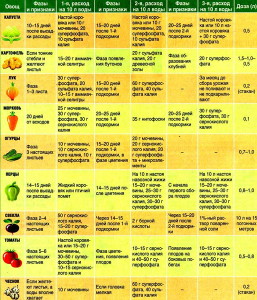
Therefore, having decided to try out new mineral fertilizers for vegetables in practice, carefully study the instructions, read reviews on gardeners' forums on the Internet. Many are stopped by the belief that all new fertilizers are clean water chemistry. But it is not always the case. Take, for example, the same liquid top dressing. You can prepare the amount you need yourself, or you can buy concentrated dressings for industrial vegetable crops. The second option saves time and is significantly superior in its effectiveness to "home-made" top dressing., since the concentrate has an optimally balanced composition.

3 A word about manure and compost
Manure or compost is perhaps the most famous type of fertilizer for all summer residents and gardeners in our large country. The presence of a manure heap or compost pit on the farm indicates a desire to grow a large crop. Natural organics will never hurt, but, as with any other fertilizer, the recommendations for use should be followed.
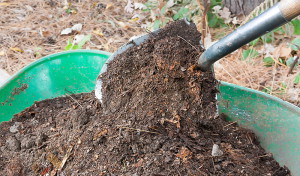
The rules are as follows:
- for cattle manure - 3 kg / m 2;
- for compost - up to 5 kg / m 2;
- for bird droppings - up to 1 kg / m 2.

Please note that fresh manure it is not recommended to apply to the soil due to the presence of many weed seeds in it. But in rotted compost there will be much less of them.
A good harvest is the goal pursued by most gardeners and gardeners. For its implementation, one important thing is necessary: good fertility of the soil layer and the presence in it of a sufficient amount of nutrients that plants need for normal growth and development. Often, the land on which it is planned to plant a particular crop does not have all the necessary characteristics - too high acidity or alkalinity, lack of one or another macronutrient, as well as other problems. To solve them, various complex fertilizers are used to compensate for the lack of necessary substances in the soil.
There are two main categories of fertilizers: mineral and organic. The first have a quick effect on the soil, saturating it with chemical elements. In addition, such fertilizers are as affordable as possible at their price, and you can buy them at any store where they are present in large quantities and with different properties. But they have one significant disadvantage: if applied excessively, mineral additives can burn young leaves or plant roots, and also cause the microflora to die out, without which soil fertility itself is impossible.
The second ones are more long-term in their effect, since their decomposition requires the participation of bacteria in the soil. Such an additive is not capable of harming the microflora, but, for example, fresh manure can burn young shoots of plants, so such top dressing should also be used in moderation. The most effective is the combined use of mineral and organic fertilizers.
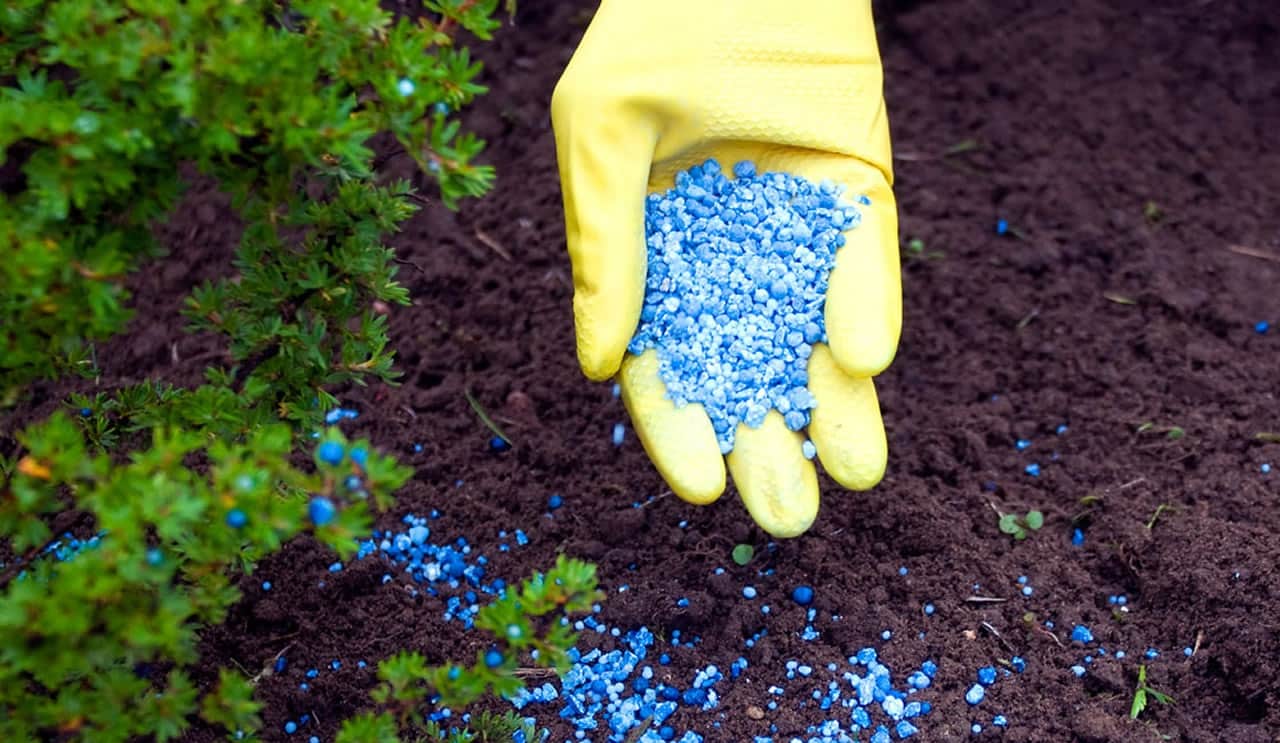
Complex fertilizers belong to the mineral category.
Types of complex fertilizers used to feed the garden
Complex fertilizer is a substance containing two or more macronutrients that are used to feed the soil and plants. The composition may contain the main elements - nitrogen, potassium or phosphorus, as well as secondary chemical elements - magnesium, calcium, zinc and others. In total, four types of such fertilizers are distinguished: nitrogen-potassium, potassium-phosphorus, phosphorus-nitrogen, and also including all three elements at once - nitrogen-potassium-phosphorus.
These funds are rightfully considered the most effective for feeding garden plants the following reasons:
How to improve productivity?We are constantly getting letters in which amateur gardeners are worried that due to the cold summer this year, a poor harvest of potatoes, tomatoes, cucumbers, and other vegetables. Last year we published TIPS about this. But unfortunately, many did not listen, but some still applied. Here is a report from our reader, we want to advise plant growth biostimulantswhich will help increase the yield by up to 50-70%.
Read...
- They contain a large amount of nutrients. At the same time, the percentage of ballast is very low;
- One granule of complex fertilizer contains several macronutrients at once;
- They can be effective for fertilizing lands in arid regions, as well as soils that are sensitive to the osmotic pressure of the applied agent.
- Ammophos;
- Diammonium phosphate;
- potassium nitrate;
- Nitrophoska;
- Nitroammophoska.
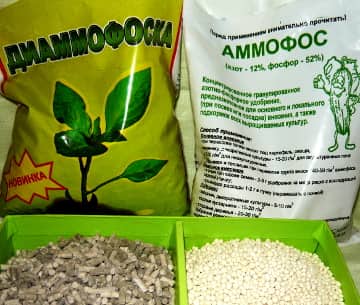
Ammophos belongs to the category of complex two-component fertilizers. It contains a large number of macronutrients: about 11 percent nitrogen, phosphorus - from 7 to 22. Also present is potassium (11 percent) and trace elements - sulfur (from 2 to 14%), calcium (0.5%) and others. Ammophos poorly absorbs moisture, but is highly soluble in the aquatic environment, which is why it is often used as a component of the solution. It is effective for feeding plants, as well as when applied to the soil layer during the sowing period in arid regions.
It is recommended to use ammophos in conjunction with ammonium nitrate- As a result, productivity increases. Among garden plants, grapes stand out with the greatest love for this fat. It is necessary to process it as follows: prepare a solution with proportions of 40 grams of the substance per liter of water, treat the area under the vines with it; After 15 days, you need to spray with a solution (15 grams per 1 liter). In addition to the fact that ammophos supplies grapes with the necessary nutrients, it also removes nitrates, which are harmful to humans, from fruits.
In general, garden plants should be fertilized with ammophos as follows: fruit trees - apply in the main period near the trunk circle in the amount of 15 to 30 grams per meter, fertilize from 5 to 10 grams per meter; berry bushes - apply in the main period from 15 to 30 grams per meter, as a top dressing - about 5 grams per meter; flowers - similar to berry bushes, but with a limitation in the main period of up to 20 grams per meter.
Top dressing of tomatoes and peppers with complex fertilizers
Diammonium phosphate can be used for gardening at any time by various methods of application to the soil. Among fruit garden plants, diammophos is the most effective for fertilizing grapes and strawberries. Grapes, which always need a lot of phosphorus, receive it in large quantities, and the presence of nitrogen in such top dressing has a positive effect on the development of the plant.
Attention! Diammonium phosphate is considered to be a more effective means for feeding grapes compared to traditional superphosphates.
It is necessary to fertilize fruit trees with diammophos at the rate of 15 to 25 grams per square meter of the trunk circle. For garden strawberries - about five grams per groove 1 meter long.

Potassium nitrate helps the development and strengthening of the root system of plants. Therefore, it is often used during transplantation as a root and foliar feeding. It also improves taste qualities yield and shelf life.
Potassium nitrate can be applied both in dry and liquid state. The latter method is more effective, since the fertilizer penetrates faster to the roots of the plant and, accordingly, enters earlier. For garden plants, it is recommended to use potassium nitrate in the following amounts:
- For ornamental crops and flowers - a solution of 1.5 grams per 1 liter of water;
- For berry crops (gooseberries, currants, blueberries, raspberries and others) - a solution of 2 grams per 1 liter;
- For fruit trees- a solution of 2.5 grams per 1 liter.
You need to make these solutions in the near-stem circle or hole - closer to the root system. For foliar feeding, a more concentrated solution is used - about 2.5 grams per 1 liter of water. For berry crops - 1 l. per square meter, for trees - from 2 to 6 liters per square meter, for flowers and strawberries - about 0.7 liters.
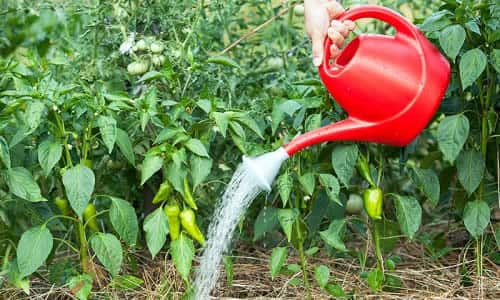
Nitrophoska is produced in granular form and is most often used for feeding flowers and ornamental garden crops, as well as some vegetables (cucumbers, tomatoes). This substance has a positive effect on the development of ornamental crops. Since nitrophoska contains a large amount of nitrogen, it should be applied in moderate doses during the growing season of flowers - around May-June.
Nitroammophoska is a mineral fertilizer, the use of which in the garden, many gardeners are apprehensive, because they believe that the nitrates contained in the substance are stored in the fruits of plants. But, as with any mineral fertilizer, moderation is the key to a good, healthy and high-quality harvest.
Nitroammophoska is effective for fertilizing fruit trees, berry bushes as well as flowers and ornamental plants. For the former, about 80 grams per trunk circle is recommended, for the latter - 65 grams (currants and gooseberries) and 40 grams (raspberries and blackberries). He also loves nitroammophoska grapes and ornamental garden plants - flowers and creepers.
 This substance can be used for foliar feeding of plants. For this, a solution is made from 2 tbsp. tablespoons of fertilizer per ten liters of water mass. Spraying should be carried out not under the bright sun and in cool weather, after which water the plants abundantly.
This substance can be used for foliar feeding of plants. For this, a solution is made from 2 tbsp. tablespoons of fertilizer per ten liters of water mass. Spraying should be carried out not under the bright sun and in cool weather, after which water the plants abundantly.
And a little about the secrets of the Author
Have you ever experienced unbearable joint pain? And you know firsthand what it is:
- inability to move easily and comfortably;
- discomfort when going up and down stairs;
- unpleasant crunch, clicking not of their own free will;
- pain during or after exercise;
- inflammation in the joints and swelling;
- causeless and sometimes unbearable aching pain in the joints ...
Now answer the question: does it suit you? Can such pain be endured? And how much money have you already "leaked" for ineffective treatment? That's right - it's time to end this! Do you agree? That is why we decided to publish an exclusive interview with Oleg Gazmanov, in which he revealed the secrets of getting rid of joint pain, arthritis and arthrosis.
Attention, only TODAY!
Complex fertilizers contain two, three main nutrients. In addition, they also contain trace elements. Using, complex mineral fertilizer I plants grow better and get sick less. In this article, we will talk about some fertilizers.
Monophosphate- This is a mineral fertilizer, which contains phosphorus and potassium. It is highly soluble in water, it is used for plant nutrition mainly after July 15: 1 teaspoon per 10 liters of water.
Azofoska- mineral fertilizer, which contains phosphorus, potassium and nitrogen predominates. It is used to increase the green mass of plants in the spring.
 is a complete mineral fertilizer containing nitrogen, phosphorus, potassium with a predominance of nitrogen and 18 trace elements in chelated form. It gives the maximum growth of green mass, is used in the initial stage of growing plants. Preparation solution: 2 teaspoons per 10 liters of water.
is a complete mineral fertilizer containing nitrogen, phosphorus, potassium with a predominance of nitrogen and 18 trace elements in chelated form. It gives the maximum growth of green mass, is used in the initial stage of growing plants. Preparation solution: 2 teaspoons per 10 liters of water.
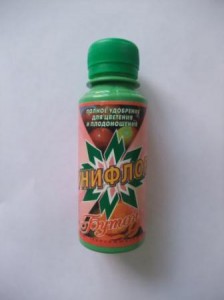 Uniflor - bud is a complete mineral fertilizer with 18 trace elements in a chelated form with a predominance of potassium and phosphorus. Stimulates budding, flowering, ripening of fruits and seeds. It is intended for flowering and fruiting plants, for flowering seedlings. Preparation of the solution: 2 teaspoons per 10 liters of water. Top dressing 1 time in 10 days. You can use the solution together with watering, only in a low concentration: 1 teaspoon per 10 liters. water.
Uniflor - bud is a complete mineral fertilizer with 18 trace elements in a chelated form with a predominance of potassium and phosphorus. Stimulates budding, flowering, ripening of fruits and seeds. It is intended for flowering and fruiting plants, for flowering seedlings. Preparation of the solution: 2 teaspoons per 10 liters of water. Top dressing 1 time in 10 days. You can use the solution together with watering, only in a low concentration: 1 teaspoon per 10 liters. water.
 Uniflor - micro- contains 18 trace elements in a chelate, available form for plants. Plants are watered with this fertilizer under the root, sprayed. The solution is prepared: 2 teaspoons per 10 liters of water.
Uniflor - micro- contains 18 trace elements in a chelate, available form for plants. Plants are watered with this fertilizer under the root, sprayed. The solution is prepared: 2 teaspoons per 10 liters of water.
AVA- it is an alloy of phosphorus and potassium - it starts working in the soil only at an air temperature of +8  degrees. It has a beneficial effect on the complex of soil microorganisms. Saturates the soil with available forms of phosphorus, magnesium, calcium and trace elements.
degrees. It has a beneficial effect on the complex of soil microorganisms. Saturates the soil with available forms of phosphorus, magnesium, calcium and trace elements.
 Ammophos- contains 10% nitrogen, from 40-70% phosphorus. This phosphorus-nitrogen fertilizer is highly soluble in water, but with little sediment, acidifies the soil. It is applied on all soils under all crops, especially those that require more phosphorus. Can be applied to holes and rows. The dose of application is 20-30 gr. per 1 sq.m.
Ammophos- contains 10% nitrogen, from 40-70% phosphorus. This phosphorus-nitrogen fertilizer is highly soluble in water, but with little sediment, acidifies the soil. It is applied on all soils under all crops, especially those that require more phosphorus. Can be applied to holes and rows. The dose of application is 20-30 gr. per 1 sq.m.
- contains nitrogen from 18-20%, phosphorus 50%. It is a phosphorus-nitrogen fertilizer. It dissolves in water and is applied on all soils, for all crops. It can be applied as an independent fertilizer and in the form of top dressing. The efficiency is higher than that of Ammophos, since no additional nitrogen is needed, the solubility is good. The dose of application is 30-40 gr. per 1 sq. m.
Diamophoska- contains nitrogen 10%, phosphorus 26%, potassium 26%.
Nitroammophoska A, B, C- contains 13-17% nitrogen, 17-19% phosphorus and 17-19% potassium. The dose of application is 70-80 gr. per 1 sq.m. is a good fertilizer.
crystallon- This is a water-soluble, chlorine-free fertilizer of the Buysky plant. Refers to environmentally friendly products. Recommended for growing vegetables, flowers, fruits.
